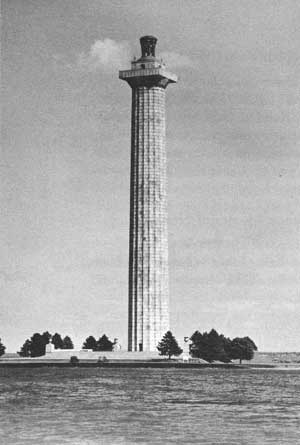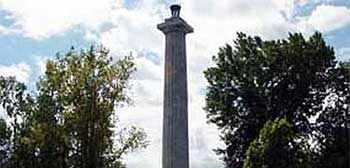





Survey of Historic Sites and Buildings
 |
PERRY'S VICTORY AND INTERNATIONAL PEACE MEMORIAL
NATIONAL MONUMENT Ohio |
 Perry's Victory and International Peace Memorial National Monument |
| ||
This memorial near Put-in-Bay, where Commodore Oliver Hazard Perry won a decisive naval battle in the War of 1812, also commemorates the many decades of peace between the United States and Canada and the principle of international peace by arbitration and disarmament as symbolized by the unfortified boundary between two North American neighbors. Perry's victory over a British fleet in the Battle of Lake Erie, as the engagement near Put-in-Bay is known, had far-reaching results on the War of 1812. It assured control of the lake for the United States and made possible a successful advance by Gen. William Henry Harrison's army into Canada, where it defeated a British-Indian force at the Thames River. The combined land and naval successes enabled the United States to retain the old Northwest under the terms of the Treaty of Ghent, in 1814. Just 3 years later, representatives of Britain and the United States signed the Rush-Bagot Agreement, which limited naval warships and armaments on the Great Lakes and was the first step toward permanent disarmament of the 4,000-mile boundary between the two countries.
 |
| Perry's Victory and International Peace Memorial National Monument, Ohio, commemorates Perry's triumph over a British fleet in the Battle of Lake Erie (1813). It also symbolizes more than a century and a half of peace between the United States and Canada. |
In 1812 an unprepared United States declared war on Great Britain because of the violation of her commercial and naval rights during the struggle between Great Britain and Napoleonic France that began in 1793. On land, during the first part of the war, U.S. military operations failed. Despite brilliant individual victories by American ships in duels with British vessels, the British effectively blockaded the ocean coastline and controlled the vital Lake Erie lifeline for troops and supplies.
In mid-1813 a British squadron under Commodore Robert H. Barclay was blockading Erie, Pa. There Commodore Oliver H. Perry was building ships, behind the low sandbar protecting the harbor, to contest British domination of the lake. Early in August Barclay relaxed his watchfulness for a few days, and Perry seized the long-awaited opportunity. Moving his nondescript fleet across the sandbar, he freed it for action. He established headquarters at Put-in-Bay, on South Bass Island, so that he could observe Barclay. He then made contact with General Harrison, commander of the U.S. Army in the Northwest, at the time in northern Ohio.
On September 9 Barclay left his base at Fort Malden, on the Detroit River, and sailed into the lake. The next morning the two fleets, each of which had assigned about 440 men, met about 10 miles west-northwest of South Bass Island. Seeking to take advantage of his edge in firepower, Perry assigned each of his nine vessels one of the six enemy ships to fight. His flagship, the Lawrence, bore the brunt of the battle. By mid-afternoon, four-fifths of the crew were casualties, and the ship was a floating wreck. Under heavy fire, Perry transferred in a rowboat to the Niagara and continued to direct the desperate fight. Only minutes there after the wounded Barclay, his flagship destroyed and his other ships badly disabled, surrendered. British casualties were slightly larger than the American, but both sides had losses of more than 100. Perry sent General Harrison a concise and dramatic message that announced his victory to the world: "We have met the enemy and they are ours: Two Ships, two Brigs one Schooner & one Sloop."
 |
| Perry's Victory and International Peace Memorial. |
The memorial covers more than 22 acres. The monument is constructed of concrete and pink Massachusetts granite. The fluted shaft is one of the most massive Doric columns ever built. It consists of 78 courses of granite, is 352 feet high, and is 45 feet in diameter at the base. Its cap serves as an observation platform, reached by an elevator, above which is a bronze urn 32 feet in height, 18 feet in width, and weighing 11 tons. The rotunda is constructed of Tennessee and Italian marble, Indiana limestone, and granite. Carved on the walls are the names of the U.S. vessels and casualties. In a crypt beneath the floor are the remains of the three American and three British officers killed in the battle. In the west doorway of the rotunda is a bronze tablet, upon which is engraved the provisions of the Rush-Bagot Agreement of 1817.
 |
 |
http://www.cr.nps.gov/history/online_books/founders-frontiersmen/sitea25.htm
Last Updated: 29-Aug-2005